Do Rottweilers Shed?
(And how to minimize shedding)
Updated By Matt Clayton 5 Weeks Ago
If you have a Rottweiler or are thinking of adopting one, you probably wonder how much they shed. After all, the goal is to live in harmony with your dog, and not always be stressed about the amount of fur they leave behind.
Although dogs are lovable pets and companions, you need to consider which breed is the perfect match for you.
Other breeds have a coat that requires more grooming, while other breeds need a lot of exercise. One factor you need to count in is shedding.
How much do Rottweilers shed, and how does that affect all the grooming and cleaning that needs to be done?
Let's find out.
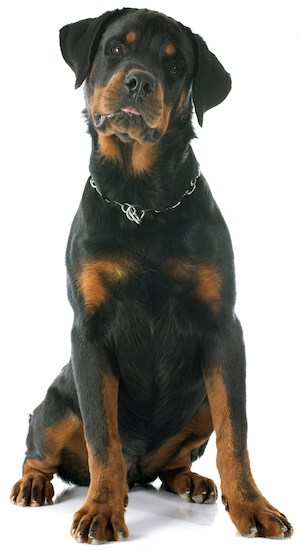
Seasons
Thanks to the changes in seasons that many of us experience, your dog will shed accordingly. In the spring and summer, where it is usually quite warm, the dog will shed his undercoat as a means of keeping cool.
Meanwhile, during other seasons such as winter, your dog will keep that undercoat as it is like having an extra layer of protection against that harsh winter wind and bone-chilling temperatures, especially when taking a walk or going to the potty spot.
Type of Coat
Some dogs have what we call single coats, meaning they do not have a layer called the "undercoat." Other dogs are known as double coats, meaning they do have a topcoat as well as an undercoat. As you can imagine, this affects how your Rottweiler sheds.
The double coat is marked by a soft, short coat underneath the primary coat, which you can see if you brush back the fur, and then an outermost coat with the brown and black colors you are used to seeing on a Rottweiler.
Losing the Puppy Hair
As puppies grow into dogs, they may lose some hair along the way to make room for new hair as they get bigger.
Puppies and dogs are mammals, and just like us humans, the shedding of hair is a common and normal part of our daily lives and growing.
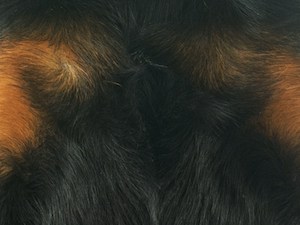
Age
As dogs get older, they may lose their hair, and rottweilers are no exception. When an older dog loses hair, it is slow to grow back, and you may notice some bald spots.
Other signs of aging in dogs include dry skin and graying hair, which is a product of lessened cell activity. The hair will also be more sparse and prone to damage, as well as brittle.
Nutrition
A deficiency in nutrients can do a number on your dog's coat. Dogs that are fed a homemade diet that is lacking in nutrients, or dogs that are fed low-quality commercial dog foods, may experience hair loss because they are not getting all the nutrients they need for a shiny and healthy coat.
Foods that contain excess nutrients can also lead to a deficiency. Look for signs such as dull hair, sparse hair, split ends, hair color changes, scaly skin, or pressure sores.
And to prevent this from affecting your dog, make sure to feed high-quality foods to your Rottweiler.
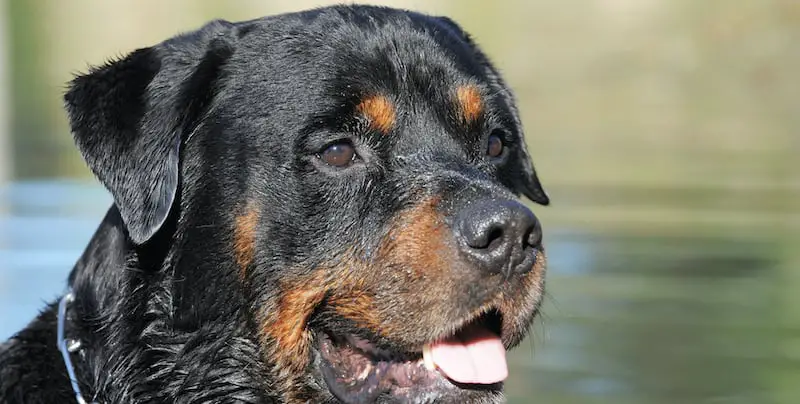
Health
There are a good number of illnesses that your Rottweiler can develop, as well as health conditions that can lead to hair loss in your dog.
It is not necessarily the same as shedding, which is natural-rather; this is a result of an affliction that must be treated by a veterinarian.
Hormonal Cycles
This section is devoted to those of you with female rottweilers. Females in the heat cycle undergo physical changes that bring lots of stress to the animal, such as bloody mucus discharge.
The estrus cycle is hard on your dog, and the hormones going through your pet may lead to more shedding/hair loss than you are used to seeing. Your dog's body is telling her to find a mate, and if she cannot find one, she may experience anxiety or even act out in aggressive ways.
Stress manifests itself through these emotions and actions, but also through hair loss. Estrogen levels are very high in female dogs during this period, which also may cause hair to fall out.
Whether or not your female Rottie is in heat, you should keep an eye on her to verify hair loss is not due to some other health problem.
Lifestyle
Some dogs live indoors mostly. Others live outdoors. Some dogs live in tropical climates, others in places where it's mostly cold.
The bottom line is that dogs with different lifestyles will have different shedding patterns.
If your dog loves to stay outside or is a guard dog, he will need a thicker coat to stay warm during those times outdoors. It works the same for summer, too- if your dog is outside a lot during the hot months, they will shed that undercoat.
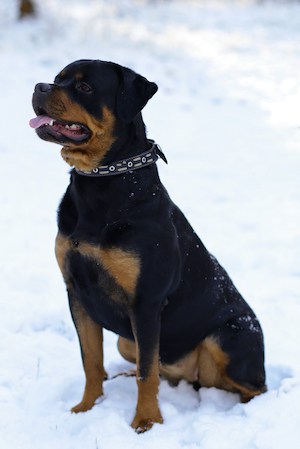
Meanwhile, a Rottie that lives mostly indoors, where air conditioning and heating are a fact of life; they will not need as much insulation compared to another dog. Dogs that live indoors will shed about the same amount all year long compared to "outdoor" dogs.
Baths
It's a good idea to limit showers for your puppy or dog. Puppies or dogs should not be bathed until they reach about 7-8 weeks of age when they can regulate their body temperatures.
Bathing leaves the pups open to getting chilled. You should also use a quality shampoo that is safe and will protect the coat on your Rottweiler. It will prevent the dog from itching or scratching as a result of using a shampoo that irritates their skin.
After all, a dog can itch so much in a particular spot that hair loss occurs. Skin can also become dry and flaky when a dog is bathed too often. As a general rule, once a month is okay.
How to Reduce Rottweiler's Shedding Problems?
Proper grooming and nutrition habits are going to be your secret weapons in keeping your Rottie looking and feeling her best.
Grooming should be done often, and only a quick brushing is usually enough. It's best to brush your Rottweiler at least once a week so that excess hair can be removed, and oils naturally found on the skin can be spread around.
These oils help keep the hair of your dog looking shiny and promotes good hair health. It takes just a good 10-minute brushing to get your dog looking great, as Rotties are pretty low-maintenance in the hair department.
Grooming your Rottweiler is not hard. Start by getting yourself a good slicker brush, or soft-bristle brush. The former is better because slicker brushes are great for dogs with a double coat.
- Begin by putting your dog at ease. Talk to him, scratch his ears. You might even provide a small treat, so he associates grooming with a good thing.
- Feel for any bites, bumps, or lumps. This way, you can know which spots to avoid and help you detect any health issues that might be present in your dog. It's an excellent way to prevent and treat skin diseases.
- Now it's time to brush. Brush with the grain, not against it. It will help pull out loose and dead hair.
- Start at the top of the head and work toward the hindquarters. Some dogs may not like the use of long brush strokes. You can use shorter ones if it helps put your dog at ease.
- The undercoat tends to grow around the neck and thighs, so make sure that you give extra attention to those areas. Make sure as you brush, that the bristles rub against the skin. It will stimulate blood flow to the area, help the hair grow, and get the natural body oils spread around. It also feels great on the skin of your dog.
- Begin when they are small. This way, they will always be used to grooming. Brushing time for puppies should be shorter, as their attention span is not as long as adult dogs.
- Regular grooming will keep your home and clothing free of fur. It's a good idea to do it outside if the weather is nice - the backyard or the dog park is a good idea. Make sure if you do it in a public area to collect the fur in a bag and discard it responsibly. Otherwise, you might brush your dog on an old blanket at home and then shake it outdoors once done.
- Bathing once a month or when needed is important. It will not only keep your dog smelling great but will keep skin oils in check. Healthy skin means less hair loss.
- Good nutrition also matters. Make sure your dog is fed a quality, vet-recommended brand of food and always has access to clean, fresh water. Cheap commercial foods and homemade diets can lead to nutritional deficiencies, which can lead to hair loss in dogs.
Causes of Excessive Shedding
Your Rottweiler may shed for several reasons.
For example, having a poor diet thanks to nutritionally poor homemade foods or low-quality commercial foods can be a reason dogs shed.
Some diseases can also affect your dog and cause him to lose hair. Here are some examples:
Cushing's Disease
Your Rottweiler produces too much of the hormone cortisol. Symptoms of this may also include an increase in weight, increased thirst, and need to go potty, and recurring infections. A veterinarian will treat the dog using surgery or medicine.
Ringworm
This is actually a fungal infection and not a parasite. It will make the puppy or dog itch and cause hair loss. You will notice crusty or scaly skin patches, which are the most recognizable symptom of ringworm. Treatment via decontaminating the dog's environment, medication, and topical treatments from a vet will help heal your pet.
Mange
A type of parasitic infection, this disease happens as a result of tiny parasitic mites on dogs. There are two kinds of mange: Sarcoptic and Demodectic. Sarcoptic mange will cause an intense and frantic need to scratch; Demodectic mange leads to bald patches appearing on your dog's coat.
The patch will not usually look dangerous, as in it won't look irritated, or inflamed- but should still be treated with the help of a vet right away. It should be noted that demodectic mange happens more often in younger dogs and pups.
If you suspect your puppy has demodectic mange, look for hair loss around the face and muzzle, specifically the eyes. The front legs are also a zone in which hair loss can happen. A vet will help you with an anti-parasitic drug.
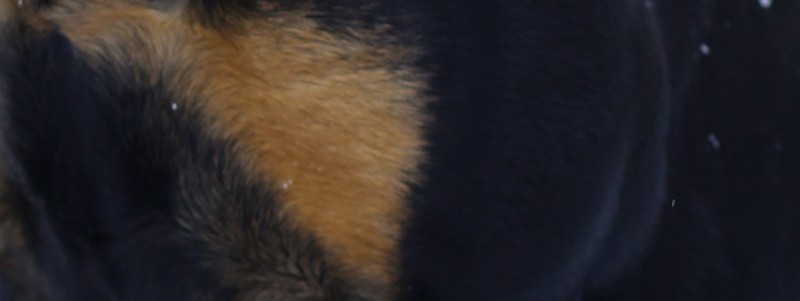
Yeast Infections
Yeast infections are a common reason for hair loss in puppies. Moist areas, such as skin folds and behind the ears, are zones in which these infections start.
It should be noted that breeds with naturally wrinkly bodies, like pugs or English Bulldogs, are more susceptible to this affliction thanks to their natural body type, but it can happen to Rotties, too.
Look for hair loss, oily skin, and an odor if you suspect your Rottweiler has a yeast infection. Bathing your dog using an anti-fungal shampoo is an excellent first step before seeing the vet, who can prescribe a remedy such as Zymox with Hydrocortisone. This medication is specially formulated to aid in the treatment of yeast infections.
Hypothyroidism
Hair loss can happen when your dog is affected by hypothyroidism. If your dog is acting more lethargic than usual, packing on the weight, and has brittle and dry hair and/or patches of hair loss, your dog could be experiencing this condition. Make sure to see a vet immediately as dogs are more open to infection with hypothyroidism.
FAQ
There is no way to prevent your dog from shedding completely. However, regular brushing, monthly baths or baths when needed (such as a day of playing in the mud), and good nutrition will keep your dog's hair in great shape. Make sure you get yourself a good bristle brush, or a slicker brush, as these tend to work best on Rottweiler coats.
Rottweilers actually shed moderately throughout the year, but there are occasions when they shed more heavily. Most dogs will shed in the spring and the fall as they prepare for the hot and cold seasons, respectively. Females will shed when they are in heat, as the stress and high levels of estrogen can affect hair loss.
Finally, if a dog is outdoors often, he will shed more to accommodate himself to the temperatures outside. On the other hand, if a dog lives mostly indoors, he will not shed as much as indoor temperatures are regulated.
It could be due to a number of things. Is your dog sick? Make sure to monitor your dog's behavior. If they are acting in a way that is not themselves, call a vet to be sure. If your dog is female, she may be in heat, and the stress of this cycle is causing her to lose her hair.
Your Rottie may also not be getting the right food. Make sure your dog is eating quality, vet-approved dog food and drinking clean, fresh water so that you can rule out nutritional deficiencies as the cause.
Rottweilers do shed, but it is very manageable with a few essential tools like a slicker brush, quality shampoo, and of course, a gentle hand. Start grooming early and often, and you and your Rottie will both feel better about it!


